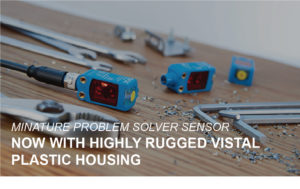 Excerpt from SICK’s June 15 release
Excerpt from SICK’s June 15 release
CIMTEC announced SICK’s latest generation of miniature photoelectric sensors earlier this year, the W4F. This small sensor packs a big punch, and we just can’t stop talking about it! A new ASIC platform delivers numerous performance advantages to this product family. For example, these sensors can detect jet black, highly reflective, flat, or transparent objects with the utmost reliability. The W4F can also provide distance information, such as the height of objects and, as a result, identify process errors. Initial users have confirmed that the photoelectric sensors have the best ambient light and sunlight suppression on the market as well as maximum immunity to all known sources of optical interference.
The Blue Pilot operating concept combined with the innovative monitoring options make configuring and monitoring the sensors easier than ever which saves time during commissioning. IO-Link and new smart functions for sensor monitoring and diagnostics create the link to the digitalized machine and application world. The W4F provides maximum performance in the smallest installation space, reliable switching behavior and a guaranteed process setup, even in the new applications that open up for the W4F.
The next generation W4F with its highly rugged Vistal® plastic housing offers sensor functions and performance characteristics that were previously only available in the larger W16 and W26 product families from SICK. The Blue Pilot operating concept has been implemented in the W4F. The next generation of miniature photoelectric sensors offer the same look and feel – a consistency that makes operating and commissioning sensors significantly easier for users.
New ASIC platform delivers increased performance
CIMTEC customers have benefited from SICK products for years and the new ASIC platform brings them a significant performance boost for opto-electronic miniature sensors with the W4F, accomplishing up to a 47 percent greater working distance than the preceding product family of photoelectric proximity sensors and a 38 percent less black/white shift between the object and background. This also applies to the improved active detection of sources for optical interference in the vicinity of the machine environment, and the suppression of this interference. The high level of immunity to interference is achieved thanks to the integration of an additional diffuse LED which is a first for this type of sensor. The background suppression of the W4F, which is significantly superior to that of other models in the market, guarantees a continuous machine operation with no interference from the surroundings.
The foundation for this performance is the development of a new ASIC that enables both the two light-intensive pin-point emitter LEDs and the diffuse LED to be operated concurrently without any appreciable heating of the sensor. This avoids the risk of a temperature-related failure. The ASIC also directly digitizes the photocurrents of the reflected light at each pixel of the multipixel receiver. This enables the sensor to achieve not only a very high sensitivity but also a long sensing range and reliable detection behavior even for poorly reflecting object surfaces.
In addition, the digital filters of the ASIC guarantee the best ambient light suppression on the market today. This ensures reliable processes. Additional process and diagnostics data as well as supplementary operation-related information such as temperatures and operating hours can also be collected. The W4F offers the most features and functional reliability on the market. Users benefit from the continuous and fault-free availability of the sensors as well as failure-free operation of machines.
The right sensor solution for any task
The next generation W4F portfolio comprises two sensor business field: Optical Standard and Optical Experts. The sensors in the Optical Standard business field have proven themselves in the field as space-saving and high performance allrounders for object detection. The sensors are a through-beam photoelectric sensor and a photoelectric retro-reflective sensor, each with a long sensing range as well as two photoelectric proximity sensors with background suppression. One of the photoelectric proximity sensors offers an exceptionally concentrated light beam and point geometry (narrow beam). This enables the sensor to also detect jet black objects with a remission of less than one percent.
For especially challenging situations, users can trust in the Optical Experts because these SICK sensors have been designed for specific applications. With the help of its laser-like light spot, its V-optics, and its specially tailored optics design, the V-Optics variant can reliably detect even the most reflective or transparent objects such as wafers or displays. To precisely detect thin objects or labels, SICK offers a photoelectric proximity sensor with two LEDs and a high-performance foreground suppression.
A photoelectric proximity sensor with two line-shaped light spots (DoubleLine) ensures a continuous switching signal even for objects with holes, drillings, or recesses. Photoelectric proximity sensors that output distance values and feature a MultiSwitch functionality – i.e., with two switching points – monitor the correct mounting of components in assembly processes. In food packaging applications they can distinguish between upright and horizontal, report high and low fill levels, and monitor the diameter of film, packaging material, or label rolls.
Want to see the SICK W4F in action?
Our engineers are ready to give you an on-site demo. Learn more about the SICK W4F Photoelectric Sensor here. Or call us at 877.524.6832

